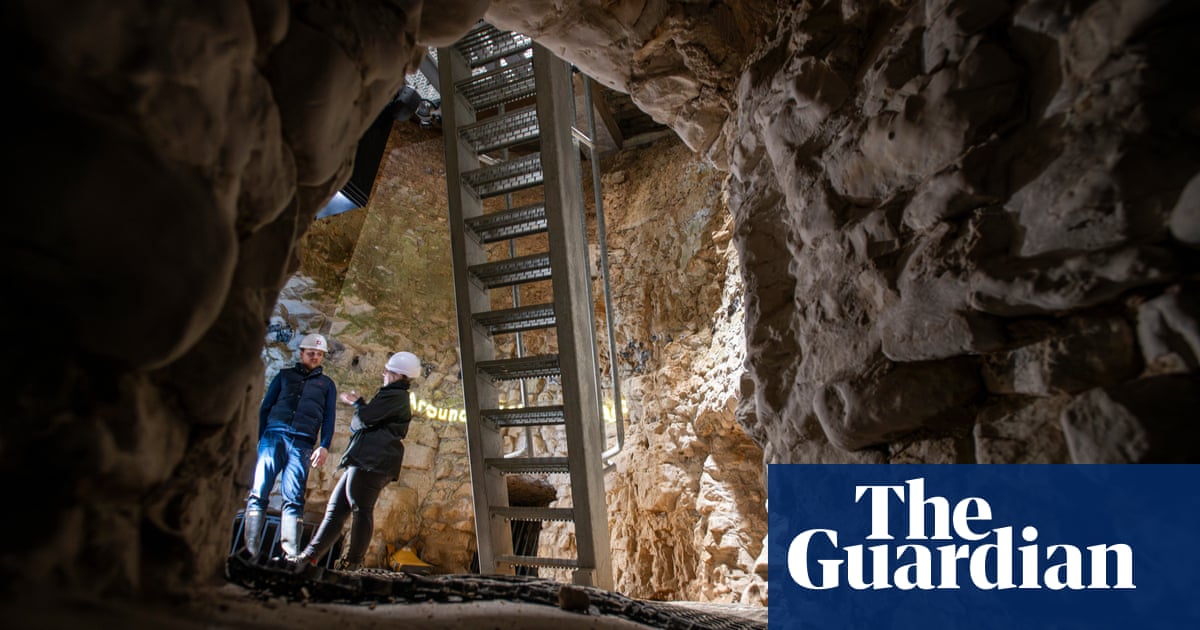
Nine metres below the grass level of an undulating Norfolk field, at the bottom of a very deep hole, Jennifer Wexler is talking about what makes this subterranean space particularly special.
“I’ve spent a lot of time crawling around [down here], and you can go into certain spaces where you see someone’s tool and think: someone just put that down 4,500 years ago, and it’s still here,” she says.
“You can literally see their marks on the wall, the tools they used, it’s a really unique experience. And that’s why for me, every time I go down, it’s completely magical.”
Wexler is the senior properties historian for Grime’s Graves, a remarkable prehistoric site near Thetford where for several centuries in the late neolithic period, people dug huge mineshafts deep into the Norfolk chalk, scratching with nothing more than deer antlers to reach seams of precious jet black flint.
More than 430 pits have been identified, some up to 14 metres deep and 12 metres in diameter, though there may be as many as 600.
Almost uniquely among Neolithic sites in England, visitors have long been able to climb down a rickety ladder to the base of one of the mineshafts to explore an authentic late stone age site for themselves.
Now English Heritage, which looks after the site, has installed a new mineshaft entrance and considerably safer and easier ladder, opening this weekend, which aims to make the experience accessible to as many as possible over the age of seven.
Though the nature of the site means full wheelchair access may never be possible, a number of information films can be viewed by all at the mineshaft entrance.
Visitors are also encouraged to roam over the deeply strange grassy landscape, pockmarked with the craters of backfilled mines and itself a site of special scientific interest.
The site is loosely contemporary with Stonehenge, which is also looked after by English Heritage, but the two attractions could scarcely be more different.
Grime’s Graves has no large coach parks or flashy visitor centre; there isn’t even a tea shop.
Instead, driving up a bumpy single lane reveals a tiny visitor centre and shop housed in what was once an archaeologists’ hut, alongside which the organisation has installed an informative if modest new exhibition.
From ground level, at first glance, there is little to see except the countless huge craters in the grass.
All the same, argues Dickon Whitewood, the curator of collections for the site, Grime’s Graves is just as impressive a site as its more famous contemporary.
In order to make tools, the people who constructed the site could easily have collected flint from the surface, he says; even underground, they dug past two more easily accessible seams of the stone to reach the deepest “floor stone” seam.
What’s more, the earliest pits, dated by the antlers used to scrape them out of the rock, were in the most inaccessible part of the site.
“These were sophisticated people that understood structural engineering and geology and yet they started at the part of the minefield where it was hardest to get the flint they were looking for.
“So there is a sense that it is the conspicuous difficulty of getting the material that was important to them,” he says.
“That’s why I think of Grime’s Graves an inverted monument. At Stonehenge, everything’s above ground; here it’s all below ground. In terms of that feat of skill, engineering, time effort, it’s just as impressive. It’s just all below our feet.”
The name Grime’s Graves derives from the Anglo-Saxon god Grim, or Woden/Odin, an association that predates the Norman conquest. It was first extensively excavated in the mid-19th century.
With only a tiny proportion of the shafts still having been explored, however, many questions remain.
Archaeologists know that the pits were being dug only in the summer months, for instance, but have not yet found any evidence of where the miners were living – or where they may have come from to do so.
“We feel quite separated from these people,” says Wexler, but when standing at the base of one of their mine shafts, “I want people to feel a connection to them and realise that these people are the same as us, they have the same brains as us, the same thoughts.
“It’s just that their world was different. And to get more of a sense of that world is really important.”












